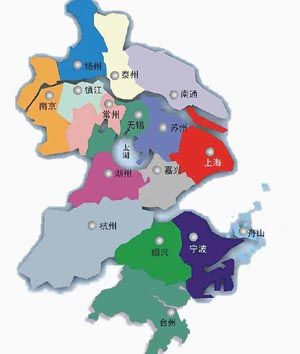 The Yangtze River Delta Economic Circle
The Yangtze River Delta borders Tongyang Canal on the north, Hangzhou Bay on the south, Zhenjiang in the west and the Pacific Ocean in the east. It entails city of Shanghai, the south part of Jiangsu Province, the north part of Zhejiang Province and the east parts neighboring the ocean, totaling area to 210,700 square kilometers.
As mentioned above, city of Shanghai is the center of the Yangtze River Delta, second-layered by city of Nanjing, Hangzhou, Suzhou, Wuxi and Ningbo as the sub-center. Functionally speaking, in the area of ‘2P (Jiangsu and Zhejiang Provinces), 1C (city of | Shanghai)’, there are 16 focally-wielded cities as Shanghai, Hangzhou, Nanjing, Ningbo, Suzhou, Wuxi, Changzhou, Zhenjiang, Yangzhou, Taizhou (Jiangsu), Nantong, Jiaxing, Huzhou, Shaoxing, Zhoushan and Taizhou (Zhejiang).
Being the largest Economical Circle in China, and the sixth biggest City Conglomerate in the world, the Yangtze River Delta has enjoyed the finest infrastructure as well as the highest synergy of competitiveness in China, thanks to its gifted geographical position, abundant national resources and profoundly built foundation in economic infrastructure. | | Tooled by only 2.1% and 11% of total land and population respectively, the Yangtze River Delta produces nationally 21.7% of GDP, 24.5% fiscal revenues and 47.2% of total foreign trade. Resultantly, it ranks the highest scale of economic development, and efficiency of implementation. Its system develops organically, for example, the area of urban and rural is efficiently as well as comprehensively connected. With the advent of bullet train of ‘Shanghai-Hangzhou shuttle’ and ‘Shanghai-Ningbo shuttle’, the Yangtze River Delta would become ‘One Hour within-reach Economic Circle’. |
|

